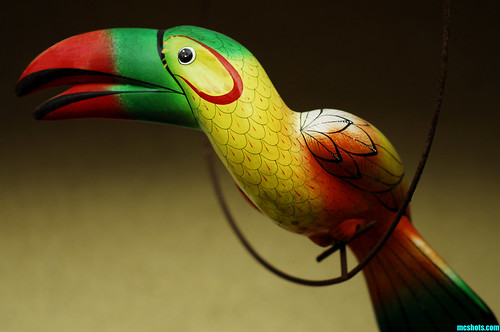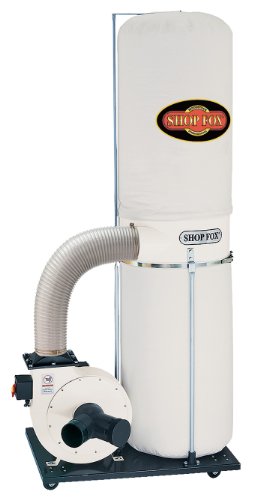Friday, January 27, 2012
Dust Collection on the Router, by Eurekazone
Friday, January 20, 2012
Rockler Dust Right Wall Mount Dust Collector
!9#:Rockler Dust Right Wall Mount Dust Collector
Brand : Dust RightRate :

Price :
Post Date : Jan 20, 2012 17:33:04
Usually ships in 1-2 business days
Heavy-duty performance meets out-of-the-way convenience. With a 650
CFM suction capacity and a 3/4 HP, 60 Hz, 110 Volt, 12 amp motor, this compact dust collector handles serious shop messes without cluttering up your workspace. It mounts in seconds with a simple Z-bracket. Plus, it's portable! Just set up a few Z-brackets around your shop or house to create dust-collection stations wherever you're working. A comfortable foam-gripped handle makes transportation and setup a breeze. The
motor features a sealed shaft and bearings for quiet, long lasting operation. The inlet accepts 4'' hose.
Comes standard with a 15 gallon, 30-micron bag. The optional 5-micron replacement bag offers the same size and capacity as the original, but with much finer particle retention. Both bags are made from heavy-duty cloth and attach easily. Includes one Z-bracket and mounting hardware. Additional Z-brackets sold separately.
Technical Details:
Heavy-duty performance plus out-of-the-way convenience.
3/4 HP, 60 Hz, 110 Volt, 12 amp motor.
Sealed bearings and shaft for quiet, durable operation.
650 CFM suction capacity.
30 micron dust collector bag keeps dust particles in place without sacrificing air flow.
Easily portable, just add mounting clips wherever you'll need it.
Dust collection inlet accepts a standard 4" dust hose.
Comfort grip carrying handle allows for easy portability.
Wall mounting bracket with included hardware attaches easily to any wall.
What's in the Box?
One Dust Right Wall Mount Dust Collector
One Z-Bracket
Best Used With:
Dust Right Floor Sweep System (36134)
Lg 47ld650 Clearance Sale Top 10 Diaper Size Cuisinart Griddler Review
Friday, January 13, 2012
Wallace Nutting Hand - Colored Photographs
Wallace Nutting sold more hand-colored photographs during America's 1900-1940 "Golden Age of Hand-Colored Photography" than any other photographer of his time. It is estimated that between 5,000,000-10,000,000 of his pictures decorated the walls of middle class American homes during the early 20th century. Why was Wallace Nutting so successful? And why are his pictures still being widely collected today? This article represents a basic introduction into the world of Wallace Nutting Pictures.
It was shortly after 1900 that Wallace Nutting retired from the ministry due to ill health (he was a Congregational Minister in Providence RI at the time). As part of his recovery, he began touring the New England countryside by carriage or car, taking photographs of rural New England. Nutting was one of the first to recognize that the American scene was changing. Industrialization was altering the way our country looked and our pure and picturesque landscape would never look the same again. He seemed to feel it his divine calling to record the beauty of America for future generations.
Beginning first in Vermont, then Massachusetts and Connecticut, and eventually throughout the rest of New England, Nutting began photographing country lanes, streams, rivers, lakes, orchards, blossoms, birches, and mountains. Wallace Nutting would take the photograph, assign a title, and instruct his colorists how it should be hand-tinted. Each picture that met Nutting's high standards of color, composition, and taste would be affixed to its matting and signed by his employees with the distinctive "Wallace Nutting" name. (He hardly ever signed any pictures by himself). Those pictures that did not meet his strict standards were destroyed. Beginning first with outdoor (Exterior) scenes in New England, Nutting eventually traveled throughout the United States and Europe, taking photographs in 26 states and 17 foreign countries between 1900-1935. Overall, he took more than 50,000 pictures, 10,000 of which he felt met his high standards. The balance were destroyed.
It was around 1905 that Nutting began taking his first indoor (Interior) pictures. Supposedly one day while it was raining outside, Mrs. Nutting suggested that he take a more "Personable" picture indoors. So, he set up a colonial scene, near a kitchen hearth, had an employee dress up in a colonial fashion, and took several different pictures. These sold relatively easily which encouraged him to expand more into this area. Nutting's love of antiques, his passion for the pilgrim period, and his unquestionable desire to turn a profit led him to eventually purchase and restore five colonial homes:
Webb House, Wethersfield, CT Wentworth-Gardner House, Portsmouth, NH Cutler-Bartlett House, Newburyport, MA Hazen-Garrison House, Haverhill, MA Saugus Iron Works (Broadhearth), Saugus, MA
Nutting purchased these homes because he felt each represented a different period of early colonial American style and taste. It was here, along with his own homes Nuttinghame (Southbury, CT) and Nuttingholme (Framingham, MA), that the majority of his Interior pictures were taken. Nutting's desire to provide the most correct and appropriate settings for his Interior scenes led him in his quest to gather one of the best collections of early American furniture ever assembled. He would use the best examples of early American furniture in his Interior scenes and, when he couldn't find it, he would reproduce it. (We'll focus on his reproduction furniture in a subsequent article).
Working in Southbury CT from 1905-12, and then in Framingham MA from 1912 until his death in 1941, Nutting sold literally millions of his hand-colored photographs. He claims to have sold around 10,000,000 pictures although, knowing his habit of exaggeration, that number is probably somewhat high.
Whatever the true number, it was large. Wallace Nutting pictures were sometimes called "poor man's prints". Sold throughout the first quarter of the 20th century, well before the invention of color photography, these pictures initially sold literally for pennies. His market was primarily the middle and lower middle classes...those households which could not afford finer forms of art. Because of their low price, Wallace Nutting pictures were purchased in large numbers. By 1925, hardly an American middle-class household was without one as they were purchased as gifts for weddings, showers, Christmas, birthdays, and for just about any other reason imaginable.
Nutting sold many pictures directly through his studios where he also provided his own framing services. But he also sold his pictures through many other outlets as well: department stores, drug stores, and gift shops, all around the country. He even had full-time salesmen on the road whose sole job was to sell his pictures to these retail establishments. Salesmen whom, he claims, sold enough pictures to retire quite handsomely themselves.
The height of Wallace Nutting picture popularity was 1915-25. During this time Nutting had nearly 100 colorists in his employment, along with another 100 employees who acted as framers, matters, salesmen, management, and assorted administrative office personnel. Let there be no mistake about it...Wallace Nutting's pictures were big business. But by the late 1920's, people began to tire of Wallace Nutting. As with any other fashion or style, tastes began to change with time. Wallace Nutting pictures became passé and sales showed a steady decline. Even the introduction of different matting styles, greeting cards, pen-type silhouettes, and lower priced machine-produced process prints could not rejuvenate sales.
The Wall Street crash of 1929 and the following depression all but sealed the fate of the Wallace Nutting picture business. Although it remained in operation even after his death, the output was inconsequential after the early 1930's. Over the years, millions of Wallace Nutting pictures were probably thrown away. Many of those that remain show the signs of 60-90 years of wear after being stored in attics and basements, with water stains, broken glass, dust, dirt, and mildew.
As the original owners of Wallace Nutting pictures have grown older or passed on, their Wallace Nutting pictures have also been passed on to another generation. Some were given directly as gifts, others were inherited by children and grandchildren. Those that weren't passed along to families were sold at auctions, estate sales, tag sales, and flea markets where they re-entered the collectibles mainstream during the 1975-2000 period.
What are collectors looking for? Just as in Wallace Nutting's time, Exterior scenes have the widest appeal. Interior scenes have a more limited appeal, but since they are rarer, they typically command a higher price than Exterior scenes. However, we have seen that as America's fascination with the "Country" look has diminished over the past 5-10 years, interest in Nutting's Interior scenes has softened as well.
The most desirable pictures to serious Nutting collectors are Miscellaneous Unusual Scenes. These are pictures which fall outside the more standard Interior and Exterior scenes: Architecturals, Children, Florals, Foreign, Men, Seascapes, Snow scenes, and a select few geographical rarities. Nutting's original sales in these categories were significantly lower than with his Exterior and Interior scenes, hence their "/i>rarity" attracts collectors. Just as in other areas of collecting, the rarest examples, in the best condition, are the easiest to sell, regardless of price. But just as important as rarity and subject matter is condition. Collectors want pieces in excellent condition and imperfections such as water stains, blemishes, poor coloring, or damaged frames can all significantly reduce value.
As of 2010 the Auction record for a Wallace Nutting hand-colored photograph stands at ,300.00, which is quite reasonable within the high-priced world of Antiques & Collectibles. However, as the economy has softened, so too have Wallace Nutting prices and perhaps 90% of Wallace Nutting pictures are selling in today's market for less than 0-0. And many can be had for - or less. Which means that if you appreciate Wallace Nutting Pictures, this is probably the best time to buy them in the past 25 years.
Bose Cinemate Home Theatre Right Now Price Epson Moviemate 72 Projector Coat Rack Ikea Discounted
Saturday, December 31, 2011
Keen Router Dust Collector Presented by Woodcraft
Hydroponic Systems Buy Now Cheaper Bose 321 Series 2 Medela Pump In Style Shoulder Bag Get It Now!
Friday, December 23, 2011
SHOP FOX W1685 1.5-Horsepower 1,280 CFM Dust Collector
!9#: SHOP FOX W1685 1.5-Horsepower 1,280 CFM Dust Collector
Powerful Shop Fox dust collector features a heavy-duty 12in. steel impeller and a 1.5 HP, 16 Amp 110V single phase motor that operates at 3450 RPM. Generates 1280 CFM air suction to capture dust and debris from any woodworking saw, planer, jointer, band saw, shaper or sander with a dust port. HP: 1 1/2, Volts: 110, CFM: 1,280, Hose Diameter (in.): Dual 4in. ports off a 6in. inlet
Manual Treadmill Order Top 10 Cuisinart Griddler Heavy Training Bag Right Now
Friday, December 16, 2011
Camfil Farr APC - 2010 A Look Back
Sunday, December 4, 2011
Shane Hall & The Dust Collectors accomplish "Gotta Serve Somebody" and "Until You Feel"
Top 10 Ijoy Chair City Select Jogger Best Pampers With Dry Max Buy Now


